| Llanos Basin | |
|---|---|
| Cuenca Llanos | |
 The Llanos Basin in Puerto López, Meta | |
| Coordinates | 05°24′00″N 71°40′00″W / 5.40000°N 71.66667°W |
| Etymology | Llanos Orientales Spanish: "eastern plains" |
| Region | Orinoquía |
| Country | |
| State(s) | Arauca, Boyacá, Casanare, Cundinamarca, Guainía, Guaviare, Meta, Norte de Santander |
| Cities | Villavicencio, Yopal |
| Characteristics | |
| On/Offshore | Onshore |
| Boundaries | Colombia-Venezuela border (N), Guiana Shield (E), Vaupés Arch (S), Serranía de la Macarena (SW), Eastern Ranges (W) |
| Part of | Andean foreland basins |
| Area | 96,000 km2 (37,000 sq mi) |
| Hydrology | |
| River(s) | Orinoco watershed Main rivers: Arauca, Meta, Guaviare, Vichada |
| Geology | |
| Basin type | Foreland on rift basin[note 1] |
| Plate | South American[note 2] |
| Orogeny | Break-up of Pangea (Mesozoic) Andean (Cenozoic) |
| Age | Paleozoic or Jurassic[note 3] to Holocene |
| Stratigraphy | Stratigraphy |
| Faults | Eastern (W, bounding), Chichimene & Meta |
| Field(s) | Rubiales, Caño Limón, many more |
The Llanos Basin (Spanish: Cuenca Llanos) or Eastern Llanos Basin (Spanish: Cuenca de los Llanos Orientales) is a major sedimentary basin of 96,000 square kilometres (37,000 sq mi) in northeastern Colombia. The onshore foreland on Mesozoic rift basin covers the departments of Arauca, Casanare and Meta and parts of eastern Boyacá and Cundinamarca, western Guainía, northern Guaviare and southeasternmost Norte de Santander. The northern boundary is formed by the border with Venezuela, where the basin grades into the Barinas-Apure Basin.
Description
The northeastern part of Colombia is characterized by its wavy plains, called Llanos Orientales, as part of the bigger Llanos that extend into Venezuela. The landscape is similar to a savanna and is poor in trees. It is located between the Eastern Ranges of the Colombian Andes in the west, the Vaupés Arch in the south and the Guiana Shield in the east.[1]
Geologically, the Llanos Basin underlies this typical landscape of the Llanos. An area where transport occurs mostly by small boats along the many rivers and the "buses of the Llanos", the Douglas DC-3 planes. The basin covers an area of 96,000 square kilometres (37,000 sq mi) and contains a stratigraphic column from the Paleozoic to recent.[2] Several of the formations in the basins are source rocks (Gachetá, Los Cuervos, Carbonera C8), reservoir rocks (Mirador, Barco, Guadalupe and the uneven numbered members of Carbonera). Seals are formed by the shaly intervals (even numbered) of the Carbonera Formation, Los Cuervos, and León.[3]
The basin is the main petroleum producing basin of Colombia, with four of the nations biggest oil fields located in the Llanos Basin. Major fields are Rubiales, Colombia's biggest and most recent giant discovery sealed by a complex of hydrodynamic processes, and Caño Limón, at the border with Venezuela.
Major concerns in the basin for the production of petroleum are biodegradation, hydrocarbon migration, fault seal capacity and water flow.
Hydrography

The Llanos Basin is crossed by numerous rivers, all belonging to the Orinoco watershed. From north to south:
- Arauca River
- Bojabá
- Margua
- Orinoco River
- Capanaparo
- Cinaruco
- Tomo
- Elvita
- Bita
- Meta River
- Guaviare River
- Vichada River
- Muco
- Tillava
Flora and fauna
Fauna

Among other species, Lynch's swamp frog (Pseudopaludicola llanera) is endemic to the Llanos, with the species epithet referring to the plains.[4] Also the whip scorpion Mastigoproctus colombianus is reported from the Llanos Basin.[5]
Geodynamic situation
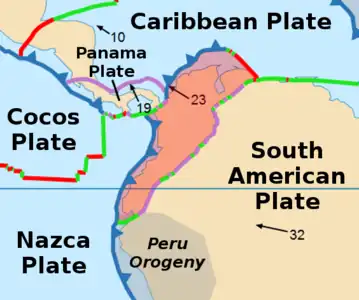
Nazca Plate has been subdivided into Coiba and Malpelo Plates

The country of Colombia spreads out over six tectonic plates, clockwise from north:
The Llanos Basin is situated entirely on the South American Plate, bordering the North Andean Block or North Andean microplate in the west. The basin is one of three Colombian basins on the South American Plate, to the south the Caguán-Putumayo Basin and to the southeast the Vaupés-Amazonas Basin. The northern boundary of the Llanos Basin is formed by the Colombia-Venezuela border where the basin grades into the Barinas-Apure Basin on the Venezuelan side. The Catatumbo Basin, representing the Colombian portion of the larger Maracaibo Basin borders the Llanos Basin in the northwest and the western boundary is formed by the foothills (Piedemonte) of the Eastern Cordillera Basin, the sedimentary basin covering the Eastern Ranges of the Colombian Andes.
Tectonics
The basin is bound to the west by the Eastern Frontal Fault System, a 921.4 kilometres (572.5 mi) long fault system connecting the North Andes and South American Plates and thus the Eastern Cordillera Basin and the Llanos Basin. The fault system has an average strike of 042.1±19, but this orientation varies greatly along its course. The 1827, 1834, 1917, 1967, 1995, and 2008 earthquakes were all caused by fault movement as part of the system.[6]
Basin history
The tectonic history of the Llanos Basin, a foreland basin formed on top of Mesozoic rift basins, Paleozoic metasediments and Precambrian basement underlain by continental crust, goes back to the Early Jurassic.
The Andean orogeny, represented by the tectonic uplift of the Colombian Eastern Ranges and its northern extension, the Serranía del Perijá, caused tilting and uplift in the Llanos Basin. During the Andean orogenic phase, the paleotemperatures in the basin dropped considerably; in the Baja Guajira area from 115 °C (239 °F) in the Early Miocene to 70 °C (158 °F) in the Late Miocene.[7] In the Late Miocene to Pliocene, the major faults to the southwest of the Cocinetas Basin, the Oca and Bucaramanga-Santa Marta Faults were tectonically active.[8]
Basement
.JPG.webp)
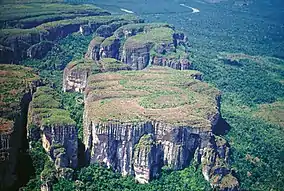
The stratigraphy of the Llanos Basin ranges, depending on the definition from either Jurassic or Paleozoic to recent. The basement is formed by the westernmost extensions of the Guiana Shield. Remnants of these Precambrian formations are found as inselbergs in the far east of Colombia (Cerros de Mavecure), in the Serranía de la Macarena to the southwest of the basin and in the tepuis of the Serranía de Chiribiquete to the southeast.
The Proterozoic crystalline rocks are overlain by metamorphosed sedimentary and igneous rocks ranging in age from Cambrian to Devonian. Younger and contemporaneous Paleozoic deposits are only found in the subsurface and in regional correlative units as the Floresta and Cuche Formations of the Altiplano Cundiboyacense to the direct northwest and the Río Cachirí Group of the Cesar-Ranchería Basin farther northwest of the Llanos Basin.
The units found in the Llanos Basin pertain to the Farallones Group and comprise the Valle del Guatiquía Red Beds, Pipiral Shale and the Gutiérrez Sandstone.[9]
Stratigraphy
| Ma | Age | Paleomap | Regional events | Catatumbo | Cordillera | proximal Llanos | distal Llanos | Putumayo | VSM | Environments | Maximum thickness | Petroleum geology | Notes |
|---|---|---|---|---|---|---|---|---|---|---|---|---|---|
| 0.01 | Holocene | 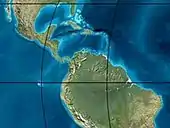 | Holocene volcanism Seismic activity | alluvium | Overburden | ||||||||
| 1 | Pleistocene |  | Pleistocene volcanism Andean orogeny 3 Glaciations | Guayabo | Soatá Sabana | Necesidad | Guayabo | Gigante Neiva | Alluvial to fluvial (Guayabo) | 550 m (1,800 ft) (Guayabo) | [10][11][12][13] | ||
| 2.6 | Pliocene |  | Pliocene volcanism Andean orogeny 3 GABI | Subachoque | |||||||||
| 5.3 | Messinian | Andean orogeny 3 Foreland | Marichuela | Caimán | Honda | [12][14] | |||||||
| 13.5 | Langhian | Regional flooding | León | hiatus | Caja | León | Lacustrine (León) | 400 m (1,300 ft) (León) | Seal | [13][15] | |||
| 16.2 | Burdigalian | Miocene inundations Andean orogeny 2 | C1 | Carbonera C1 | Ospina | Proximal fluvio-deltaic (C1) | 850 m (2,790 ft) (Carbonera) | Reservoir | [14][13] | ||||
| 17.3 | C2 | Carbonera C2 | Distal lacustrine-deltaic (C2) | Seal | |||||||||
| 19 | C3 | Carbonera C3 | Proximal fluvio-deltaic (C3) | Reservoir | |||||||||
| 21 | Early Miocene | Pebas wetlands | C4 | Carbonera C4 | Barzalosa | Distal fluvio-deltaic (C4) | Seal | ||||||
| 23 | Late Oligocene |  | Andean orogeny 1 Foredeep | C5 | Carbonera C5 | Orito | Proximal fluvio-deltaic (C5) | Reservoir | [11][14] | ||||
| 25 | C6 | Carbonera C6 | Distal fluvio-lacustrine (C6) | Seal | |||||||||
| 28 | Early Oligocene | C7 | C7 | Pepino | Gualanday | Proximal deltaic-marine (C7) | Reservoir | [11][14][16] | |||||
| 32 | Oligo-Eocene | C8 | Usme | C8 | onlap | Marine-deltaic (C8) | Seal Source | [16] | |||||
| 35 | Late Eocene |  | Mirador | Mirador | Coastal (Mirador) | 240 m (790 ft) (Mirador) | Reservoir | [13][17] | |||||
| 40 | Middle Eocene | Regadera | hiatus | ||||||||||
| 45 | |||||||||||||
| 50 | Early Eocene |  | Socha | Los Cuervos | Deltaic (Los Cuervos) | 260 m (850 ft) (Los Cuervos) | Seal Source | [13][17] | |||||
| 55 | Late Paleocene | PETM 2000 ppm CO2 | Los Cuervos | Bogotá | Gualanday | ||||||||
| 60 | Early Paleocene | SALMA | Barco | Guaduas | Barco | Rumiyaco | Fluvial (Barco) | 225 m (738 ft) (Barco) | Reservoir | [10][11][14][13][18] | |||
| 65 | Maastrichtian |  | KT extinction | Catatumbo | Guadalupe | Monserrate | Deltaic-fluvial (Guadalupe) | 750 m (2,460 ft) (Guadalupe) | Reservoir | [10][13] | |||
| 72 | Campanian | End of rifting | Colón-Mito Juan | [13][19] | |||||||||
| 83 | Santonian | Villeta/Güagüaquí | |||||||||||
| 86 | Coniacian | ||||||||||||
| 89 | Turonian | Cenomanian-Turonian anoxic event | La Luna | Chipaque | Gachetá | hiatus | Restricted marine (all) | 500 m (1,600 ft) (Gachetá) | Source | [10][13][20] | |||
| 93 | Cenomanian |  | Rift 2 | ||||||||||
| 100 | Albian | Une | Une | Caballos | Deltaic (Une) | 500 m (1,600 ft) (Une) | Reservoir | [14][20] | |||||
| 113 | Aptian |  | Capacho | Fómeque | Motema | Yaví | Open marine (Fómeque) | 800 m (2,600 ft) (Fómeque) | Source (Fóm) | [11][13][21] | |||
| 125 | Barremian | High biodiversity | Aguardiente | Paja | Shallow to open marine (Paja) | 940 m (3,080 ft) (Paja) | Reservoir | [10] | |||||
| 129 | Hauterivian |  | Rift 1 | Tibú- Mercedes | Las Juntas | hiatus | Deltaic (Las Juntas) | 910 m (2,990 ft) (Las Juntas) | Reservoir (LJun) | [10] | |||
| 133 | Valanginian | Río Negro | Cáqueza Macanal Rosablanca | Restricted marine (Macanal) | 2,935 m (9,629 ft) (Macanal) | Source (Mac) | [11][22] | ||||||
| 140 | Berriasian | Girón | |||||||||||
| 145 | Tithonian | Break-up of Pangea | Jordán | Arcabuco | Buenavista Batá | Saldaña | Alluvial, fluvial (Buenavista) | 110 m (360 ft) (Buenavista) | "Jurassic" | [14][23] | |||
| 150 | Early-Mid Jurassic | 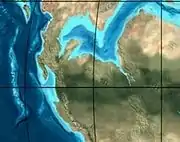 | Passive margin 2 | La Quinta | Montebel Noreán | hiatus | Coastal tuff (La Quinta) | 100 m (330 ft) (La Quinta) | [24] | ||||
| 201 | Late Triassic | 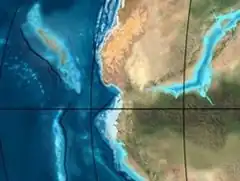 | Mucuchachi | Payandé | [14] | ||||||||
| 235 | Early Triassic |  | Pangea | hiatus | "Paleozoic" | ||||||||
| 250 | Permian |  | |||||||||||
| 300 | Late Carboniferous |  | Famatinian orogeny | Cerro Neiva () | [25] | ||||||||
| 340 | Early Carboniferous | Fossil fish Romer's gap | Cuche (355-385) | Farallones () | Deltaic, estuarine (Cuche) | 900 m (3,000 ft) (Cuche) | |||||||
| 360 | Late Devonian |  | Passive margin 1 | Río Cachirí (360-419) | Ambicá () | Alluvial-fluvial-reef (Farallones) | 2,400 m (7,900 ft) (Farallones) | [22][26][27][28][29] | |||||
| 390 | Early Devonian |  | High biodiversity | Floresta (387-400) El Tíbet | Shallow marine (Floresta) | 600 m (2,000 ft) (Floresta) | |||||||
| 410 | Late Silurian | Silurian mystery | |||||||||||
| 425 | Early Silurian | hiatus | |||||||||||
| 440 | Late Ordovician |  | Rich fauna in Bolivia | San Pedro (450-490) | Duda () | ||||||||
| 470 | Early Ordovician | First fossils | Busbanzá (>470±22) Chuscales Otengá | Guape () | Río Nevado () | Hígado () | [30][31][32] | ||||||
| 488 | Late Cambrian |  | Regional intrusions | Chicamocha (490-515) | Quetame () | Ariarí () | SJ del Guaviare (490-590) | San Isidro () | [33][34] | ||||
| 515 | Early Cambrian | Cambrian explosion | [32][35] | ||||||||||
| 542 | Ediacaran |  | Break-up of Rodinia | pre-Quetame | post-Parguaza | El Barro () | Yellow: allochthonous basement (Chibcha Terrane) Green: autochthonous basement (Río Negro-Juruena Province) | Basement | [36][37] | ||||
| 600 | Neoproterozoic | Cariri Velhos orogeny | Bucaramanga (600-1400) | pre-Guaviare | [33] | ||||||||
| 800 |  | Snowball Earth | [38] | ||||||||||
| 1000 | Mesoproterozoic |  | Sunsás orogeny | Ariarí (1000) | La Urraca (1030-1100) | [39][40][41][42] | |||||||
| 1300 | Rondônia-Juruá orogeny | pre-Ariarí | Parguaza (1300-1400) | Garzón (1180-1550) | [43] | ||||||||
| 1400 |  | pre-Bucaramanga | [44] | ||||||||||
| 1600 | Paleoproterozoic | Maimachi (1500-1700) | pre-Garzón | [45] | |||||||||
| 1800 | Tapajós orogeny | Mitú (1800) | [43][45] | ||||||||||
| 1950 | Transamazonic orogeny | pre-Mitú | [43] | ||||||||||
| 2200 | Columbia | ||||||||||||
| 2530 | Archean | 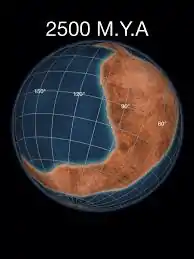 | Carajas-Imataca orogeny | [43] | |||||||||
| 3100 | Kenorland | ||||||||||||
| Sources | |||||||||||||
- Legend
- group
- important formation
- fossiliferous formation
- minor formation
- (age in Ma)
- proximal Llanos (Medina)[note 4]
- distal Llanos (Saltarin 1A well)[note 5]
Paleozoic
- Cambro-Ordovician
- Guape Formation
- Duda Formation
- Ariarí Formation
- Ariarí Metagabbro
- Pre-Devonian
- Quetame Group
- Río Guamal Metasiltstones
- Guayabetal Phyllites and Quartzites
- San Cristóbal Quartzites and Phyllites
- Susumuco Metaconglomerates and Phyllites
- Devonian
- Farallones Group
- Valle del Guatiquía Red Beds
- Pipiral Shale
- Gutiérrez Sandstone
Jurassic
- Buenavista Breccia
Petroleum geology
The Llanos Basin is the most prolific hydrocarbon basin of Colombia, hosting well-known petroleum deposits as Caño Limón, Rubiales and other fields. Nine of the twenty most producing oil fields of Colombia are situated in the Llanos Basin.
Fields
Based on data released in March 2018, Colombia is the 21st oil producer in the world. Daily production dropped in 2017 to 854.121 thousand barrels per day (135.7944×103 m3/d).[50] In 2016, twenty oilfields produced 66% of all oil of Colombia, listed below in bold.[51] The total proven reserves of Colombia were 1,665.489 million barrels (264.7916×106 m3) in 2016.[52]
Major oil fields in the Llanos Basin are:[53]
| Name | Map | Location | Operator | Reservoirs | Reserves Production (2016) | Notes |
|---|---|---|---|---|---|---|
| Rubiales |  | Puerto Gaitán Meta | Ecopetrol | Carbonera 7 | 4,380 million bbl (696 million m3) 132.000 kbbl/d (20.9863×103 m3/d) | |
| Castilla |  | Castilla la Nueva Meta | Ecopetrol | Mirador Gachetá Une | 452 million bbl (71.9 million m3) 121.363 kbbl/d (19.2952×103 m3/d) | [54][55] |
| Chichimene | 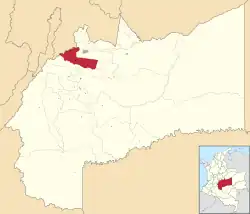 | Acacias Meta | Ecopetrol | Mirador Guadalupe Gachetá Une | 74.052 kbbl/d (11.7733×103 m3/d) | [56][57] |
| Quifa |  | Puerto Gaitán Meta | Meta Petroleum | Carbonera | 613 million bbl (97.5 million m3) 46.557 kbbl/d (7.4020×103 m3/d) | [58][59] |
| Caño Limón | Puerto Rondón Arauca | Ecopetrol | 20.930 kbbl/d (3.3276×103 m3/d) | [60] | ||
| Avispa |  | Cabuyaro Meta | Pacific Rubiales | 11.625 kbbl/d (1.8482×103 m3/d) | ||
| Ocelote |  | Puerto Gaitán Meta | Hocol | 11.228 kbbl/d (1.7851×103 m3/d) | ||
| Chipirón | Puerto Rondón Arauca | OXY | 10.459 kbbl/d (1.6628×103 m3/d) | [59] | ||
| Jacana |  | Villanueva Casanare | Geopark | 7.477 kbbl/d (1.1887×103 m3/d) | ||
| Cupiagua | 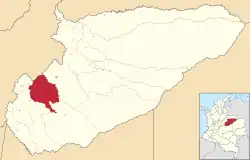 | Aguazul Casanare | Ecopetrol | 5.358 kbbl/d (851.9 m3/d) | ||
| Apiay | 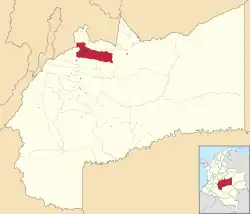 | Villavicencio Meta | Ecopetrol | Gachetá Une | ||
| Arauca | Arauca Arauca | Ecopetrol | ||||
| Cusiana | 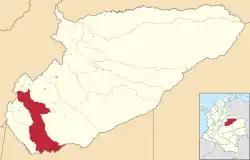 | Tauramena Casanare | Ecopetrol | Mirador Barco Guadalupe | ||
- Other fields[53]
- Caño Verde
- Chaparrito
- Concesión
- Corcel
- Cravo Sur
- La Gloria
- Santiago
- Trinidad
- Valdivia
Mining
Mining activities in the Llanos Basin are restricted to certain areas, resulting in less conflicts, more common with indigenous peoples in the Amazonian part of Colombia.[61]
In San José del Guaviare platinum is mined.[65]
| Resources | Map | Department | Municipality | Mine | Notes |
|---|---|---|---|---|---|
| halite |  | Meta | Restrepo | Upín | [63][66] |
| gold |  | Puerto Rico | [62] | ||
| Arauca | Arauca | ||||
| gold |  | Guaviare | San José del Guaviare | ||
| platinum, iron, albite, andradite (var: melanite), 'apatite', arfvedsonite, 'biotite', calcite, cancrinite, epidote, fluorite, 'garnet', microcline, 'monazite', nepheline, siderite, titanite, zircon | [65][67] | ||||
| coal |  | Casanare | Recetor | [64] | |
Paleontology

H = Honda Group
Co = Cocinetas Basin
B = Bogotá
C = Cerrejón
L = La Frontera
P = Paja
J = Valle Alto
F = Cuche and Floresta
M = Duda, La Macarena
Compared to many fossiliferous formations in Colombia, the Llanos Basin has been lean in fossil content. Most of the basin stratigraphy is only known from wells.
Paleozoic outcrops surrounding and perforating the planar geography have provided fossils dating back to the Cambrian; the Duda and Ariarí Formations.
Several fossiliferous formations of contemporaneous depositional environments have provided many unique fossils indicative of paleoclimatic conditions; turtle fossils were described from Los Cuervos in the Cesar-Ranchería Basin, and the Mirador Formation in the Catatumbo Basin direct northwest of the Llanos Basin has provided many fossil flora.[68]
- Other correlative units with surrounding basins
- Guayabo - Sabana and Soatá, Ware, Honda
- León - Honda
- Carbonera - Barzalosa, Castilletes, Jimol
- Mirador - Bogotá - Etayoa
- Los Cuervos - Cerrejón - Titanoboa, crocodylians, turtles, flora
- Los Cuervos - Guaduas - fossil flora
- Gachetá - Chipaque - oysters
- Gachetá - La Luna - many
- Une - Hiló - ammonites
- Farallones Group - Floresta and Cuche
See also
- Sedimentary basins of Colombia
- Neuquén Basin, major petroleum producing basin of Argentina
- Santos Basin, major petroleum producing basin of Brazil
- Eastern Venezuela Basin, primary petroleum producing basin of Venezuela
Sources
Notes
- ↑ More detailed: continental margin (Protero- and Paleozoic), rift basin (Mesozoic), foredeep (Paleogene and early Neogene), foreland (late Neogene to recent)
- ↑ The northernmost of three Colombian basins on this plate, to the south the Caguán-Putumayo and Vaupés-Amazonas Basins
- ↑ Depending on the definition of basement, the stratigraphic succession starts either in the Paleozoic on Proterozoic crystalline basement or Jurassic on top of both
- ↑ based on Duarte et al. (2019)[46], García González et al. (2009),[47] and geological report of Villavicencio[48]
- ↑ based on Duarte et al. (2019)[46] and the hydrocarbon potential evaluation performed by the UIS and ANH in 2009[49]
References
- ↑ Barrero et al., 2007, p.69
- ↑ ANH, 2010
- ↑ García González et al., 2009, p.58
- ↑ Pseudopaludicola llanera at IUCN.org
- ↑ Mastigoproctus colombianus at GBIF.org
- ↑ Paris et al., 2000a, p.36
- ↑ Hernández Pardo et al., 2009, p.122
- ↑ Hernández Pardo et al., 2009, p.28
- ↑ Plancha 266, 1998
- 1 2 3 4 5 6 García González et al., 2009, p.27
- 1 2 3 4 5 6 García González et al., 2009, p.50
- 1 2 García González et al., 2009, p.85
- 1 2 3 4 5 6 7 8 9 10 Barrero et al., 2007, p.60
- 1 2 3 4 5 6 7 8 Barrero et al., 2007, p.58
- ↑ Plancha 111, 2001, p.29
- 1 2 Plancha 177, 2015, p.39
- 1 2 Plancha 111, 2001, p.26
- ↑ Plancha 111, 2001, p.24
- ↑ Plancha 111, 2001, p.23
- 1 2 Pulido & Gómez, 2001, p.32
- ↑ Pulido & Gómez, 2001, p.30
- 1 2 Pulido & Gómez, 2001, pp.21-26
- ↑ Pulido & Gómez, 2001, p.28
- ↑ Correa Martínez et al., 2019, p.49
- ↑ Plancha 303, 2002, p.27
- ↑ Terraza et al., 2008, p.22
- ↑ Plancha 229, 2015, pp.46-55
- ↑ Plancha 303, 2002, p.26
- ↑ Moreno Sánchez et al., 2009, p.53
- ↑ Mantilla Figueroa et al., 2015, p.43
- ↑ Manosalva Sánchez et al., 2017, p.84
- 1 2 Plancha 303, 2002, p.24
- 1 2 Mantilla Figueroa et al., 2015, p.42
- ↑ Arango Mejía et al., 2012, p.25
- ↑ Plancha 350, 2011, p.49
- ↑ Pulido & Gómez, 2001, pp.17-21
- ↑ Plancha 111, 2001, p.13
- ↑ Plancha 303, 2002, p.23
- ↑ Plancha 348, 2015, p.38
- ↑ Planchas 367-414, 2003, p.35
- ↑ Toro Toro et al., 2014, p.22
- ↑ Plancha 303, 2002, p.21
- 1 2 3 4 Bonilla et al., 2016, p.19
- ↑ Gómez Tapias et al., 2015, p.209
- 1 2 Bonilla et al., 2016, p.22
- 1 2 Duarte et al., 2019
- ↑ García González et al., 2009
- ↑ Pulido & Gómez, 2001
- ↑ García González et al., 2009, p.60
- ↑ Producción de crudo bajó en 30.879 barriles por día en 2017 - El Tiempo
- ↑ En 20 campos se produce el 66 % del petróleo del país - El Tiempo
- ↑ Oil reserves per department - 2016 - ANH
- 1 2 Mojica et al., 2009, p.30
- ↑ ANH & Halliburton, s.a., p.2
- ↑ Castilla, área petrolera especial - El Tiempo
- ↑ ANH & Halliburton, s.a., p.3
- ↑ Chichimene
- ↑ Las reservas de campo Quifa se reducen en 5,9 millones de barriles
- 1 2 Mapa de Tierras, ANH, 2017
- ↑ Caño Limón
- ↑ (in Spanish) Mapa de Territorios Indígenas y Minerales Preciosos
- 1 2 (in Spanish) Producción de oro – UPME
- 1 2 (in Spanish) Producción de sal – UPME
- 1 2 (in Spanish) Producción de carbón – UPME
- 1 2 (in Spanish) Producción de platino – UPME
- ↑ Upin at Mindat.org
- ↑ San José del Guaviare at Mindat.org
- ↑ Jaramillo & Dilcher, 2001
Bibliography
General
- Barrero, Dario; Andrés Pardo; Carlos A. Vargas, and Juan F. Martínez. 2007. Colombian Sedimentary Basins: Nomenclature, Boundaries and Petroleum Geology, a New Proposal, 1–92. ANH.
- García González, Mario; Ricardo Mier Umaña; Luis Enrique Cruz Guevara, and Mauricio Vásquez. 2009. Informe Ejecutivo - evaluación del potencial hidrocarburífero de las cuencas colombianas, 1-219. Universidad Industrial de Santander.
Hydrodynamics
- Mora, Andrés; Ricardo Andrés Gómez; Camilo Díaz; Victor Caballero; Mauricio Parra; Carlos Villamizar; Álvaro Lasso; Richard A. Ketcham, and Felipe González Penagos, John Rico and Juan Pablo Arias Martínez. 2019. Water flow, oil biodegradation, and hydrodynamic traps in the Llanos Basin, Colombia. AAPG Bulletin 103. 1225-1264. Accessed 2019-10-26.
- Duarte, Edward; German Bayona; Carlos Jaramillo; Mauricio Parra; Ingrid Romero, and Josué Alejandro Mora. 2017. Identificación de los máximos eventos de inundación marina Miocenos y su uso en la correlación y análisis de la cuenca de antepaís de los Llanos Orientales, Colombia. Boletín de Geología 39. 19-40. Accessed 2019-10-26.
- Bartha, Attila; Nelly De Nicolais; Vinod Sharma; S.K. Roy; Rajiv Srivastava; Andrew E. Pomerantz; Milton Sanclemente; Wilmar Pérez, and Robert K. Nelson, Christopher M. Reddy, Jonas Gros, J. Samuel Arey, Jaron Lelijveld, Sharad Dubey, Diego Tortella, Thomas Hantschel, Kenneth E. Peters and Oliver C. Mullins. 2015. Combined Petroleum System Modeling and Comprehensive Two-Dimensional Gas Chromatography To Improve Understanding of the Crude Oil Chemistry in the Llanos Basin, Colombia. Energy & Fuels, American Chemical Society 29. 4755-4767. Accessed 2019-10-26.
- Gómez Galarza, Yohaney; Franklin Yoris; Javier Rodríguez; Fredy Portillo, and Ysidro Araujo. 2010. Aspectos hidrodinámicos, estructurales y estratigráficos del Campo Rubiales. Geo Petróleo 9. 1-28. Accessed 2017-06-07.
- Gómez, A.; C. Jaramillo; M. Parra, and A. Mora. 2009. Huesser Horizon: A lake and marine incursion in Northwestern South America during the Early Miocene. PALAIOS 24. 199-210. Accessed 2019-10-26.
Tectonics
- Paris, Gabriel; Michael N. Machette; Richard L. Dart, and Kathleen M. Haller. 2000a. Map and Database of Quaternary Faults and Folds in Colombia and its Offshore Regions, 1–66. USGS. Accessed 2017-09-18.
- Paris, Gabriel; Michael N. Machette; Richard L. Dart, and Kathleen M. Haller. 2000b. Map of Quaternary Faults and Folds of Colombia and Its Offshore Regions, 1. USGS. Accessed 2017-09-18.
Petroleum
- Martínez Sánchez, Dilan, and Giovanny Jiménez. 2019. Hydraulic fracturing considerations: Insights from analogue models, and its viability in Colombia. Earth Sciences Research Journal 23. 5-15. Accessed 2019-10-26. ISSN 1794-6190
- Vargas Jiménez, Carlos A. 2012. Evaluating total Yet-to-Find hydrocarbon volume in Colombia. Earth Sciences Research Journal 16. 1–290. Accessed 2017-06-14.
- Mojica, Jairo; Oscar J. Arévalo, and Hardany Castillo. 2009. Cuencas Catatumbo, Cesar – Ranchería, Cordillera Oriental, Llanos Orientales, Valle Medio y Superior del Magdalena, 1–65. ANH. Accessed 2017-06-14.
- Piedrahita, Carlos, and Clara L. Montaña. 2007. Methodology implemented for the 3D-Seismic modelling using GoCad and NORSAR 3D Software applied to complex areas in the Llanos foothills. Earth Sciences Research Journal 11. 35-43. Accessed 2019-10-26.
- Hernández Pardo, Orlando; Ralph R.B. von Frese, and Jeong Woo Kim. 2007. Crustal thickness variations and seismicity of northwestern South America. Earth Sciences Research Journal 11. 81-94. Accessed 2019-10-26.
- N., N. 2006. Cuenca Llanos Orientales - Estudio Integrado - Crudos Pesados, 1-10. ANH. Accessed 2017-06-07.
Paleontology
- Jaramillo, Carlos A., and D.L. Dilcher. 2001. Middle Paleogene palynology of Central Colombia, South America: A study of pollen and spores from tropical latitudes. Palaeontographica Abteilung B 258. 87-213. Accessed 2019-10-26.
Reports
- Pinto Valderrama, Jorge Eduardo; José Pedro Mora Ortiz; Gloria Reátiga Tarazona; Jorge Alberto Rey Pilonieta; Silvia Johana Toloza Hormiga; Diego Andrés Torres Coronado; David Ricardo Vargas Mojica, and Cristian Julián Zafra Manrique. 2010. Geología del Piedemonte Llanero en la Cordillera Oriental, departamentos de Arauca y Casanare, 1-64. INGEOMINAS & Universidad Industrial de Santander. Accessed 2017-08-04.
- Terraza, Roberto; Diana Montoya; Germán Reyes; Giovanni Moreno; Jaime Fúquen; Eliana Torres Jaimes; Myriam López Cardona; Álvaro Nivia Guevara, and Fernando Etayo Serna. 2013. Geología de la Plancha 229 - Gachalá - 1:100,000, 1–296. Servicio Geológico Colombiano. Accessed 2017-08-04.
- Patiño, Alejandro; Jaime Fuquen; Julián Ramos; Andrea Pedraza; Leonardo Ceballos; Lyda Pinzón; Yadira Jerónimo; Leidy Álvarez, and Andrea Torres. 2011. Cartografía geológica de la Plancha 247 - Cáqueza - 1:100,000. INGEOMINAS. Accessed 2017-08-04.
- Acosta, Jorge E., and Carlos E. Ulloa. 2002. Mapa geológico del Departamento de Cundinamarca 1:250,000 - Memoria Explicativa, 1–108. INGEOMINAS.
- Pulido, Orlando, and Luz Stella Gómez. 2001. Geología de la Plancha 266 - Villavicencio - 1:100,000, 1–52. INGEOMINAS.
Maps
- ANH, .. 2017. Mapa de Tierras, 1. ANH. Accessed 2018-06-02.
- Departmental
- Reyes, Germán, and Ana Milena Cardozo. 1999. Mapa Geológico de Arauca 1:250,000, 1. INGEOMINAS. Accessed 2017-09-21.
- Acosta, Jorge; Carlos Ulloa; Pilar García, and Orlando Solano. 1999. Mapa Geológico de Cundinamarca, 1. INGEOMINAS. Accessed 2017-09-21.
- Rodríguez, Antonio José. 2002. Mapa Geológico del Meta 1:500,000, 1. INGEOMINAS. Accessed 2017-09-21.
- Local
- Fúquen, Jaime; Leonardo Ceballos; Andrea Pedraza, and Edwin Marín. 2010. Plancha 99 - Villa del Rosario - 1:100,000, 1. INGEOMINAS. Accessed 2018-06-01.
- Royero, José María; J. Zambrano; Rommel Daconte; H. Mendoza, and Rodrigo Vargas. 1999. Plancha 111 - Toledo - 1:100,000, 1. INGEOMINAS. Accessed 2017-06-06.
- Daconte B., Rommel, and Rosalba Salinas E. 1982. Plancha 122 - Río Cobugón - 1:100,000, 1. INGEOMINAS. Accessed 2018-06-01.
- Vargas, Rodrigo; Alfonso Arias; Luis Jaramillo, and Noel Tellez. 1984. Plancha 136 - Málaga - 1:100,000, 1. INGEOMINAS. Accessed 2017-06-06.
- López, Carolina; Camilo Dávila; Francisco González; Eduardo Parra; Claudia Chaquea; Carolina Ojeda; Carlos Q.; Valentina Espinel, and José A. Lancheros. 2011. Plancha 139 - Betoyes - 1:100,000, 1. INGEOMINAS. Accessed 2017-06-06.
- López, Carolina; Camilo Dávila; Francisco González; Eduardo Parra; Claudia Chaquea; Carolina Ojeda; Carlos Q.; Valentina Espinel, and José A. Lancheros. 2011. Plancha 155 - Puerto Rondón - 1:100,000, 1. INGEOMINAS. Accessed 2017-06-06.
- Ulloa, Carlos E.; Erasmo Rodríguez, and Ricardo Escovar. 1998. Plancha 192 - Laguna de Tota - 1:100,000, 1. INGEOMINAS. Accessed 2017-06-06.
- Terraza, Roberto; Giovanni Moreno; José A. Buitrago; Adrián Pérez, and Diana María Montoya. 2010. Plancha 210 - Guateque - 1:100,000, 1. INGEOMINAS. Accessed 2017-06-06.
- Buitrago, José Alberto; Roberto Terraza M., and Fernando Etayo. 1998. Plancha 228 - Santafé de Bogotá Noreste - 1:100,000, 1. INGEOMINAS. Accessed 2017-06-06.
- Ulloa, Carlos E; Ricardo Escovar, and Adolfo H. Pacheco. 2009. Plancha 230 - Monterrey - 1:100,000, 1. INGEOMINAS. Accessed 2017-06-06.
- Acosta, Jorge; Juan Carlos Calcedo, and Carlos Ulloa. 1999. Plancha 265 - Icononzo - 1:100,000, 1. INGEOMINAS. Accessed 2017-06-06.
- Pulido, Orlando; Luz Stella Gómez, and Pedro Marín. 1998. Plancha 266 - Villavicencio - 1:100,000, 1. INGEOMINAS. Accessed 2017-06-06.
- Duarte, Rafael; Mauricio Moreno; Carlos Julio Morales; Henry Villegas; Sonia Alvarado; Milena Téllez; Sonia Pacheco, and Nadia Rojas. 2010. Plancha 267 - Pachaquiaro - 1:100,000, 1. INGEOMINAS. Accessed 2017-06-06.
- Unión Temporal, G&H. 2015. Plancha 284 - Santana - 1:100,000, 1. Servicio Geológico Colombiano. Accessed 2018-06-01.
Further reading
- Bally, A.W., and S. Snelson. 1980. Realms of subsidence. Canadian Society for Petroleum Geology Memoir 6. 9–94. .
- Kingston, D.R.; C.P. Dishroon, and P.A. Williams. 1983. Global Basin Classification System. AAPG Bulletin 67. 2175–2193. Accessed 2017-06-23.
- Klemme, H.D. 1980. Petroleum Basins - Classifications and Characteristics. Journal of Petroleum Geology 3. 187–207. Accessed 2017-06-23.
